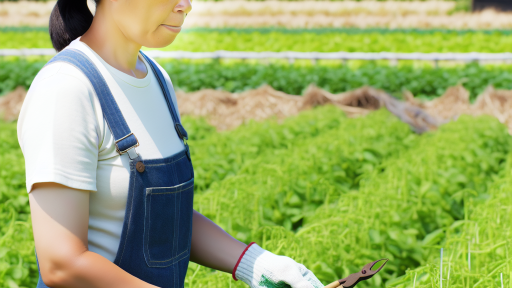Understanding the Importance of Research and Development Grants for Farmers
Supporting Agricultural Innovation
Research and development grants play a key role in agricultural innovation.
They provide farmers with essential resources to explore new practices.
Additionally, these grants enable the development of advanced technologies.
As a result, farmers can boost their productivity and efficiency.
Enhancing Sustainability
Grants allow farmers to invest in sustainable farming practices.
This investment reduces the environmental impact of agriculture.
As a result, farmers can contribute to environmental preservation.
Moreover, sustainability leads to healthier ecosystems and communities.
Increasing Competitiveness
Access to research grants enhances farmers’ competitiveness in the market.
With funding, farmers can adopt cutting-edge methods quickly.
Consequently, they can meet consumer demands more effectively.
Moreover, competitive farms are crucial for national food security.
Fostering Collaboration
Research grants often encourage collaboration among farmers and researchers.
These partnerships lead to valuable knowledge sharing and networking.
Furthermore, collaborative projects can yield innovative solutions.
Transform Your Agribusiness
Unlock your farm's potential with expert advice tailored to your needs. Get actionable steps that drive real results.
Get StartedThis synergy benefits the agricultural community as a whole.
Utilizing Available Resources
Farmers can leverage grants to access valuable resources.
This includes technical assistance, training, and expertise.
As a result, they can improve their operational practices greatly.
In addition, grants help farmers stay informed about industry trends.
Identifying Available Research and Development Grants and Programs
Understanding Different Grant Types
Farmers can access various types of research and development grants.
These may include federal, state, and private funding opportunities.
Each type of grant has distinct eligibility criteria and funding purposes.
Research grants typically support innovative projects with measurable outcomes.
Development grants often focus on implementing new technologies in farming.
Researching Grant Opportunities
Conduct thorough research to find suitable grants for your farming operation.
Start by visiting government websites dedicated to agricultural funding.
Review industry associations that may offer grant resources.
Utilize online grant databases to locate available opportunities.
Networking with other farmers can also reveal hidden funding options.
Connecting with Agricultural Extension Offices
Engage with local agricultural extension offices for assistance.
These offices provide insight into both grants and practical farming methods.
They often host workshops and informational sessions on securing funding.
Additionally, extension agents may help you refine your grant proposal.
Evaluating Grant Requirements
Carefully examine each grant’s requirements and guidelines.
Understand the application process, deadlines, and documentation needed.
Some grants require specific project plans or partnerships with research institutions.
Align your project goals with the grant objectives for better chances of success.
Be prepared to demonstrate the potential impact of your project.
Showcase Your Farming Business
Publish your professional farming services profile on our blog for a one-time fee of $200 and reach a dedicated audience of farmers and agribusiness owners.
Publish Your ProfileKeeping Track of Funding Opportunities
Establish a system to track upcoming grant opportunities.
Use calendars or project management tools to set reminders for deadlines.
Regularly check for new grants or program announcements as they arise.
Staying organized will help you respond promptly to applications.
Furthermore, consider subscribing to newsletters that provide funding updates.
Assessing Eligibility Criteria for Various Grants
Understanding Different Grant Programs
Farmers must research various grant programs available to them.
Each program offers unique funding opportunities and objectives.
Identifying these differences is crucial to applying effectively.
Identifying General Eligibility Requirements
Most grants require farmers to meet specific eligibility criteria.
Common requirements include project alignment with grant goals.
Additionally, applicants often need to demonstrate previous experience.
Financial stability and sound management practices are also key.
Specific Grant Types and Their Criteria
Different grants cater to unique agricultural sectors.
Understand the specific criteria for state and federal grants.
- Research grants often require scientific collaboration.
- Development grants may focus on innovative techniques.
- Conservation grants prioritize environmentally sustainable practices.
Gathering Required Documentation
Farmers should prepare necessary documentation before applying.
This may include business plans, budgets, and prior project reports.
Furthermore, letters of support can strengthen applications.
Ensuring all documents are complete will improve chances of funding.
Consulting with Experts
Engaging with grant writing experts can be beneficial.
They can provide insights into successful applications.
Additionally, local agricultural extensions often offer valuable resources.
Networking with other farmers who have received funds is also helpful.
You Might Also Like: Understanding Farm-To-Table Legislation: A Comprehensive Guide for Farmers
Preparing a Detailed Project Proposal
Understanding Project Objectives
Clearly define your project’s objectives from the start.
Focus on what you aim to achieve through the research and development process.
A well-stated objective guides your project’s direction and scope.
Keep your objectives specific, measurable, achievable, relevant, and time-bound.
Background Research and Rationale
Conduct thorough background research on your project topic.
This helps justify your project’s relevance and necessity.
Explain current issues or gaps in knowledge that your project addresses.
Support your rationale with statistics and credible references.
Detailed Project Description
Provide a comprehensive description of your proposed project.
Include methodologies you plan to use for research and development.
Clearly outline each phase of the project to ensure clarity.
Discuss the resources required for each phase of implementation.
Expected Outcomes and Impact
Highlight the expected outcomes of your project.
Describe how these outcomes benefit the agricultural community.
Emphasize the potential long-term impacts on sustainability and innovation.
Use concrete examples to illustrate your points where possible.
Budgetary Considerations
Prepare a detailed budget that outlines all anticipated expenses.
Showcase Your Farming Business
Publish your professional farming services profile on our blog for a one-time fee of $200 and reach a dedicated audience of farmers and agribusiness owners.
Publish Your ProfileInclude costs for materials, labor, and any necessary equipment.
Be transparent about how funds will be allocated throughout the project.
Consider potential revenue generation or savings resulting from the project.
Evaluation and Monitoring Plan
Establish a plan for monitoring and evaluating project progress.
Detail specific metrics that will measure success.
Include timelines for evaluation points during the project lifecycle.
This ensures accountability and supports effective reporting to funders.
Explore Further: Key Sources of Research and Development Funding for Agricultural Businesses
Gathering Required Documentation for Grant Applications
Identifying Necessary Documents
Start by identifying all necessary documents for your grant application.
Common documents include project proposals and budgets.
Additionally, gather proof of eligibility for each grant.
Consult grant guidelines to ensure completeness.
Organizing Your Documents
Organize your documents in a systematic manner.
Create folders for different sections of your application.
Label each document clearly for easy identification.
This process will facilitate smoother submission.
Gathering Financial Records
Compile financial records relevant to the project.
Include tax returns and recent bank statements.
Ensure your records reflect the current financial condition.
Collecting Support Letters
Reach out to collaborators and stakeholders for support letters.
These letters can significantly enhance your application.
Request letters that reflect partnerships and endorsements.
Reviewing and Finalizing Documents
Review all gathered documentation carefully.
Check for accuracy and completeness before submission.
Consider having someone else proofread your documents.
This extra step can catch any errors you might miss.
Explore Further: How Government Policies Influence Agricultural Insurance
Establishing a Budget: Cost Estimates and Funding Requests
Understanding Your Financial Needs
Begin by assessing the full scope of your project.
Identify the specific costs associated with your research and development efforts.
This may include equipment, labor, and materials.
Additionally, consider indirect costs such as utilities and overhead.
Document these expenses clearly to support your budget.
Creating Detailed Cost Estimates
Utilize past project data to inform your estimates.
Consult with experts in your field for accurate pricing.
Ensure that all estimates include a buffer for unexpected expenses.
This will help you avoid budget shortfalls later.
Regularly update your estimates as your project progresses.
Preparing Funding Requests
Your funding request should align with your budget goals.
Present a clear justification for each line item in your budget.
Be concise and direct while explaining the impact of the expenses.
Showcase Your Farming Business
Publish your professional farming services profile on our blog for a one-time fee of $200 and reach a dedicated audience of farmers and agribusiness owners.
Publish Your ProfileHighlight the potential return on investment for the funding agency.
Make sure to follow any application guidelines provided.
Utilizing Resources for Budget Preparation
Take advantage of online tools and templates for budget planning.
Consider seeking assistance from financial advisors if needed.
Peer reviews can also provide valuable feedback on your budget proposals.
Lastly, remain open to revising your budget based on feedback received.
Learn More: Guide to Renewable Energy Grants for Farmers

Submission Process: Guidelines and Best Practices
Understanding the Application Requirements
Before applying, familiarize yourself with the specific requirements.
Each grant has unique criteria to meet.
Review the eligibility guidelines thoroughly.
Highlight any necessary qualifications or experience.
Assembling Necessary Documentation
Gather all relevant documents before submission.
Your business plan plays a crucial role in your application.
Include financial statements to support your case.
Make sure you have letters of support from local organizations.
Crafting a Strong Proposal
Your proposal should clearly outline your project goals.
Detail how your project will innovate agricultural practices.
Explain the potential impact of your research and development.
Use data to support your arguments and objectives.
Budgeting Effectively
Create a detailed budget that aligns with your project.
Include all anticipated costs, such as materials and labor.
Justify each expense to show its importance to your project.
Be realistic and justified in your financial needs.
Review and Edit Your Application
Before submission, carefully review your entire application.
Check for clarity and conciseness in your writing.
Editing for grammar and spelling is crucial.
Seek feedback from peers to gain new perspectives.
Submission and Follow-Up
Ensure you submit your application before the deadline.
Double-check submission guidelines for online platforms.
Keep a record of your submission for follow-up queries.
If necessary, reach out after submission to confirm receipt.
Monitoring and Reporting Requirements After Grant Approval
Understanding Reporting Obligations
Farmers must understand their reporting obligations thoroughly.
Each grant comes with specific requirements for monitoring progress.
Non-compliance can result in penalties or funding withdrawals.
Grants usually require both financial and programmatic reports.
Financial reports detail how funds are utilized.
Programmatic reports evaluate the overall impact of the project.
Setting Up a Reporting Schedule
Establish a clear timeline for reporting submissions.
This timeline should align with the grant’s guidelines.
Regular updates help maintain transparency with funding agencies.
Showcase Your Farming Business
Publish your professional farming services profile on our blog for a one-time fee of $200 and reach a dedicated audience of farmers and agribusiness owners.
Publish Your ProfileUse a calendar to track reporting deadlines efficiently.
Timely submissions reflect good project management practices.
Collecting Required Data
Data collection is crucial for accurate reporting.
Develop a systematic approach for collecting project data.
This process should align with the grant’s performance indicators.
Utilize software tools for streamlined data management.
Regularly analyze data to assess project progress.
Engaging Stakeholders
Involve key stakeholders in the monitoring process.
Their insights can enhance project evaluations significantly.
Communicate regularly to keep everyone informed.
Stakeholder engagement fosters a collaborative atmosphere.
Documenting Progress
Keep detailed records of all project activities.
Documentation should include successes and challenges faced.
Photographs and written narratives are valuable additions.
Records serve as evidence of compliance during reviews.
Reviewing and Adjusting Strategies
Regular reviews of strategy help in managing project direction.
Make adjustments based on collected data and stakeholder feedback.
This flexibility can lead to improved outcomes.
Continuous evaluation ensures the project remains aligned with goals.
Leveraging Partnerships for Enhanced Grant Applications
The Importance of Collaborations
Partnerships can significantly strengthen grant proposals.
They allow farmers to pool resources and expertise.
Collaborating with universities or research institutes enhances credibility.
Such collaborations demonstrate a commitment to innovation.
Additionally, they can lead to more comprehensive project designs.
Identifying Potential Partners
Farmers should seek partners who share their goals.
Local agricultural organizations can provide valuable resources.
Universities often have programs focused on agricultural research.
Environmental NGOs can offer insights into sustainable practices.
State agricultural extension services can connect farmers with experts.
Building a Strong Partnership
Open communication is essential for successful partnerships.
Regular meetings can help align goals and expectations.
Defining roles and responsibilities fosters accountability.
Sharing data and resources can enhance the research quality.
Moreover, showcasing each partner’s strengths can improve the proposal.
Crafting a Compelling Grant Proposal
Collaborative projects often present unique opportunities.
Highlighting the partnership in the proposal can attract attention.
Clearly outline the contributions of each partner.
Emphasize the shared vision and complementary skills.
Furthermore, provide examples of past successful collaborations.
Securing Ongoing Support
Building a partnership does not end with the grant application.
Showcase Your Farming Business
Publish your professional farming services profile on our blog for a one-time fee of $200 and reach a dedicated audience of farmers and agribusiness owners.
Publish Your ProfileContinuing collaboration enhances the project’s success.
Establish a plan for ongoing communication and evaluation.
Regular progress reports can keep all partners engaged.
Successful partnerships can lead to future funding opportunities.
Common Mistakes to Avoid in the Application Process
Neglecting Eligibility Requirements
Farmers often overlook specific eligibility criteria for grants.
Each funding source has unique requirements.
Be proactive and carefully review these details.
Missing eligibility can lead to automatic disqualification.
Poor Proposal Planning
Many farmers rush their proposals without adequate planning.
A well-structured proposal enhances clarity and persuasiveness.
Take time to outline your project goals and methods.
Clearly define your project’s scope and objectives.
Inadequate Budgeting
Creating a detailed budget is critical for success.
Many applicants fail to justify their budget estimates.
Provide clear explanations for each expense line item.
A well-prepared budget builds trust in your proposal.
Failure to Follow Instructions
Grant applications come with strict submission guidelines.
Ignoring these instructions can lead to rejection.
Read all guidelines thoroughly to ensure compliance.
Pay attention to formatting, length, and required documentation.
Poor Communication of Impact
Clearly articulating your project’s potential impact is essential.
Highlight how your work will benefit the agricultural community.
Use data and examples to substantiate your claims.
A strong impact statement can set your proposal apart.
Submitting Last Minute Applications
Rushing to meet deadlines often results in errors.
Start your application well in advance of the deadline.
This allows for thorough revisions and feedback.
Late submissions are often not considered for funding.
Ignoring Feedback
Feedback is invaluable in the application process.
Seek input from peers or mentors before submitting.
Incorporate constructive criticism to strengthen your proposal.
Learning from past mistakes can improve future applications.




